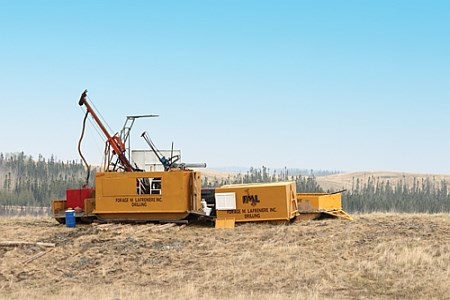Construction is potentially months away from starting on Canada’s largest undeveloped gold resource as Detour Gold Corporation gears up for its Detour Lake open pit mine, 180 kilometres northeast of Timmins.
At nearly $1 billion, the cost to build the mine is comparable to that of De Beers Canada’s price tag for the Victor diamond mine. The environmental assessment process and related permitting is expected to wrap up by late summer, with construction due to begin by late fall or early winter.
“This is a very, very aggressive schedule, but we’ve hit all the targets thus far,” says Derek Teevan, spokesperson for Detour Gold, which has completed 400,000 metres of drilling in the three years since acquiring the property.
“We’re out in the communities, and pushing the politicians, and to be frank, the Ministry of Natural Resources, Ministry of the Environment and Ministry of Northern Development, Mines and Forestry in the region have been very supportive.”
With $260 million in projected annual operating costs, the mine contains proven and provable open pit reserves of 11.4 million ounces. This ranks it sixth among North America’s top 10 largest gold reserves and translates to a 16-year mine life, with average annual gold production of 649,000 ounces.
This number may rise by the end of 2010 as the company looks to complete 90,000 metres of drilling immediately west of the open pit, of which 60,000 metres have already been completed.
Some of the infrastructure needed for the ambitious project is already in place, including 151 kilometres of paved road and 34 kilometres of gravel road access off Highway 652, alongside rail access from nearby Cochrane. An air strip and camp are also already located at the site.
The site will also need a 230-kilovolt power line, meaning that a 180-kilometre line will need to be built from the Island Falls area, just north of Smooth Rock Falls, to link from the Fraserdale Power Station.
Detour shares some of the industry’s concerns surrounding the cost of power in the province, says Teevan, as energy shapes up to be one of the largest costs facing the project.
“If we built this line in Quebec, it would actually be covered by Hydro Quebec, and they would pay for that line,” says Teevan. “Also, we’d be paying about four cents a kilowatt-hour less in energy costs.”
The company is also working towards completing additional impact benefit agreements with local Aboriginal communities, including the Wahgoshig First Nation, with whom Detour signed an agreement in principle in mid-May. Other communities include the the Taykwa Tagamou Nation and the Moose Cree First Nation, which signed memorandums of understanding with Detour in the fall of 2009.
If approvals and partnerships are obtained on schedule, the construction of the new power line may begin by the end of the year, followed by new tailings facilities.
As construction ramps up, it will create 1,200 direct jobs and 2,700 indirect jobs at peak, which will last slightly more than two years.
The plant will then be commissioned in the fourth quarter of 2012. The mill’s throughput is expected to begin at 55,000 tonnes per day (tpd), a number that will gradually increase to 61,000 tpd.
Once production begins in 2013, as many as 500 jobs will be created, with an estimated 1,200 indirect jobs needed through mine support and service work.
Teevan says the company expects to draw staff from cutbacks at mining projects throughout Northern Ontario. It’s an approach that spells out no small amount of relief for the region, which is need of a rapid infusion of new career opportunities following those lost from the closure of Xstrata’s Kidd Creek Metallurgical Site.
“For the Timmins area, this project is as big as the Ring of Fire,” says Tom Laughren, mayor of Timmins. “We need to hold Minister (of Northern Development, Mines and Forestry) Michael Gravelle’s feet to the fire on this so we can get the permits on this to get started. I don’t want to hear any excuse that we didn’t get it, or that we’re not ready, or that we need another year; this project needs to go now.”
In order to mine the pit, the company’s fleet will look to include 36 300-tonne haul trucks, two electric cable shovels, three electric-hydraulic shovels, as well as six drills and various ancillary equipment to support the mining operation.
Completed in mid-May, the mine’s feasibility study uses a price of $850 per ounce of gold for its base case, and calculates that total operating costs will reach an average of $454 per ounce.




